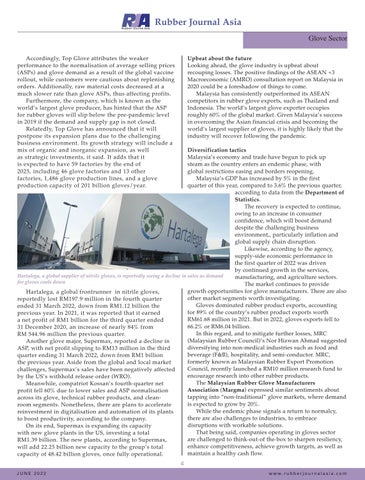Rubber Journal Asia Glove Sector Upbeat about the future Looking ahead, the glove industry is upbeat about recouping losses. The positive findings of the ASEAN +3 Macroeconomic (AMRO) consultation report on Malaysia in 2020 could be a foreshadow of things to come. Malaysia has consistently outperformed its ASEAN competitors in rubber glove exports, such as Thailand and Indonesia. The world’s largest glove exporter occupies roughly 60% of the global market. Given Malaysia’s success in overcoming the Asian financial crisis and becoming the world’s largest supplier of gloves, it is highly likely that the industry will recover following the pandemic.
Accordingly, Top Glove attributes the weaker performance to the normalisation of average selling prices (ASPs) and glove demand as a result of the global vaccine rollout, while customers were cautious about replenishing orders. Additionally, raw material costs decreased at a much slower rate than glove ASPs, thus affecting profits. Furthermore, the company, which is known as the world’s largest glove producer, has hinted that the ASP for rubber gloves will slip below the pre-pandemic level in 2019 if the demand and supply gap is not closed. Relatedly, Top Glove has announced that it will postpone its expansion plans due to the challenging business environment. Its growth strategy will include a mix of organic and inorganic expansion, as well as strategic investments, it said. It adds that it is expected to have 59 factories by the end of 2025, including 46 glove factories and 13 other factories, 1,486 glove production lines, and a glove production capacity of 201 billion gloves/year.
Diversification tactics Malaysia’s economy and trade have begun to pick up steam as the country enters an endemic phase, with global restrictions easing and borders reopening. Malaysia’s GDP has increased by 5% in the first quarter of this year, compared to 3.6% the previous quarter, according to data from the Department of Statistics. The recovery is expected to continue, owing to an increase in consumer confidence, which will boost demand despite the challenging business environment,, particularly inflation and global supply chain disruption. Likewise, according to the agency, supply-side economic performance in the first quarter of 2022 was driven by continued growth in the services, Hartalega, a global supplier of nitrile gloves, is reportedly seeing a decline in sales as demand manufacturing, and agriculture sectors. for gloves cools down The market continues to provide growth opportunities for glove manufacturers. There are also Hartalega, a global frontrunner in nitrile gloves, other market segments worth investigating. reportedly lost RM197.9 million in the fourth quarter Gloves dominated rubber product exports, accounting ended 31 March 2022, down from RM1.12 billion the for 89% of the country’s rubber product exports worth previous year. In 2021, it was reported that it earned RM61.68 million in 2021. But in 2022, gloves exports fell to a net profit of RM1 billion for the third quarter ended 66.2% or RM6.04 billion. 31 December 2020, an increase of nearly 84% from In this regard, and to mitigate further losses, MRC RM 544.96 million the previous quarter. (Malaysian Rubber Council)’s Nor Hizwan Ahmad suggested Another glove major, Supermax, reported a decline in diversifying into non-medical industries such as food and ASP, with net profit slipping to RM13 million in the third beverage (F&B), hospitality, and semi-conductor. MRC, quarter ending 31 March 2022, down from RM1 billion formerly known as Malaysian Rubber Export Promotion the previous year. Aside from the global and local market Council, recently launched a RM10 million research fund to challenges, Supermax’s sales have been negatively affected encourage research into other rubber products. by the US’s withhold release order (WRO). The Malaysian Rubber Glove Manufacturers Meanwhile, compatriot Kossan’s fourth-quarter net Association (Margma) expressed similar sentiments about profit fell 60% due to lower sales and ASP normalisation tapping into “non-traditional” glove markets, where demand across its glove, technical rubber products, and cleanis expected to grow by 20%. room segments. Nonetheless, there are plans to accelerate While the endemic phase signals a return to normalcy, reinvestment in digitalisation and automation of its plants there are also challenges to industries, to embrace to boost productivity, according to the company. disruptions with workable solutions. On its end, Supermax is expanding its capacity That being said, companies operating in gloves sector with new glove plants in the US, investing a total are challenged to think-out-of the-box to sharpen resiliency, RM1.39 billion. The new plants, according to Supermax, enhance competitiveness, achieve growth targets, as well as will add 22.25 billion new capacity to the group’s total maintain a healthy cash flow. capacity of 48.42 billion gloves, once fully operational.
4 JUNE 2022
www.rubberjournalasia.com
